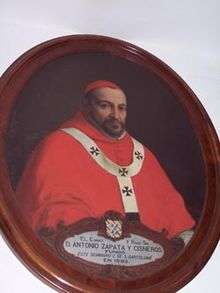Antonio Zapata y Cisneros
| Antonio Zapata y Cisneros | |
|---|---|
 | |
| Orders | |
| Consecration | 1587 |
| Created Cardinal |
6 June 1604 by Clement VIII |
| Personal details | |
| Born |
8 October 1550 Madrid |
| Died |
27 April 1635 (aged 84) Madrid |
Antonio Zapata y Cisneros, also listed as Zapata y Mendoza,[1] (Madrid, 8 October 1550 – Madrid, c. 27 April 1635) was a Spanish bishop. He served as bishop of Cádiz and Pamplona, archbishop of Burgos, cardinal, councillor of state for Philip III, Viceroy of Naples, and Inquisitor General of the realm.
Life
Ecclesiastical career
He was the first child of Francisco Zapata de Cisneros, 1st Count of Barajas, and María Clara de Mendoza; and a grand-nephew of Cardinal Cisneros.
He studied at Salamanca, graduating with a degree in Canon Law. He was named a canon and inquisitor of Toledo and later of Cuenca, where his uncle Gómez Zapata was the bishop. In July 1587 he renounced the noble title he had inherited by right of primogeniture in favor of his brother Diego, and in November that year he was made bishop of Cádiz at the urging of Philip II, and consecrated by Cardinal Gaspar de Quiroga.[2] During his episcopate he ordered the raising of part of the city walls at his own expense.
In May 1596 he was sent to the diocese of Pamplona.[3] In 1599 he was named a councillor of state, and in September the following year Philip III made him archbishop of Burgos, in which post he contributed to the ornamentation of the city's cathedral.
In June 1604 Pope Clement VIII named him a cardinal,[4] after which he resigned from the office of archbishop and moved to Rome, where he lived for the following years. He participated in the conclave of 1605 in which Pope Paul V was elected and was the inquisitor of the city.[1]
In 1617 he returned to Spain, bringing with him the remains of Saint Francis Borgia. Two years later he bestowed the cardinal's galero on Prince Ferdinand of Austria.[1]
Viceroy of Naples
In September 1620 Philip III gave him the post of Viceroy of Naples, where he arrived at the end of the year.[5] At the death of Pope Paul V the following month, Zapata traveled to Rome, where he participated in the conclave in which the new pope Gregory XV was elected; in his absence of less than a month Naples was governed by Pedro de Toledo, general of the king's galleys.
During the viceroyalty of Zapata the country suffered serious inflation caused by the systematic counterfeiting of the currency. Inclement weather, which left the kingdom isolated for several months, thereby hindering commerce, added to the precarious situation of the Neapolitans, who protested angrily against his government, leading on several occasions to physical aggression against the viceroy. In December 1622 Zapata was succeeded in his post by Antonio Álvarez de Toledo y Beaumont, 5th Duke of Alba.[6]
Return to Spain
After his return to Spain, in 1625 he was entrusted with the administration of the Archdiocese of Toledo during the minority of the titular archbishop, Cardinal-Prince Ferdinand of Austria. In a bull issued in January 1627 by Pope Urban VIII he received the post of inquisitor general of the kingdom. Five years later, now an octogenarian, his advanced age led him to resign from all his posts and retire to Barajas. Afflicted with an illness which hindered his speech, he was taken to Madrid, where he died in April 1635. His remains were buried in the Discalced Carmelite monastery of Our Lady of the Conception, founded by his father in Barajas.
He wrote a book entitled Discurso de la obligación en conciencia y justicia que los prelados tienen en proveer las dignidades y beneficios eclesiásticos ("Discourse on the prelate's obligation of conscience and justice in the provision of ecclesiastical offices and benefits"), dedicated to the Cardinal-Prince. It was published in Madrid in 1629.[7]
References
- 1 2 3 Salvador Miranda: The Cardinals of the Holy Roman Church.
- ↑ José Antonio Álvarez Baena: Hijos de Madrid vol. I, pp. 130-133 (1789).
- ↑ Gregorio Fernández Pérez: Historia de la iglesia y obispos de Pamplona, vol. III, pp. 53-56.
- ↑ "Catholic Hierarchy: Antonio Zapata y Cisneros". Retrieved 20 June 2012.
- ↑ Juan Ramírez de Arellano, a servant of Antonio Zapata, wrote an account of the voyage from Madrid to Naples at the end of 1620: Relazión de la jornada que desde Madrid a Nápoles hizo don Antonio Zapata.
- ↑ Virreyes de Nápoles, José Raneo, with annotations by Eustaquio Fernández Navarrete, pp. 408-417, included in "Colección de documentos inéditos para la historia de España", vol. XXIII.
- ↑ Álvarez Baena, op. cit., vol. IV, pags. 394-395.
| Catholic Church titles | ||
|---|---|---|
| Preceded by Luis García Haro de Sotomayor |
Bishop of Cádiz 1587 - 1596 |
Succeeded by Maximiliano de Austria |
| Preceded by Bernardo de Sandoval y Rojas |
Bishop of Pamplona 1596 - 1600 |
Succeeded by Mateo Burgos Moraleja |
| Preceded by Cristóbal Vela y Acuña |
Archbishop of Burgos 1600 - 1604 |
Succeeded by Alfonso Manrique |
| Preceded by Robert Bellarmine |
Cardinal-Priest of San Matteo in Via Merulana 1605 - 1606 |
Succeeded by Roberto Ubaldini |
| Preceded by Ascanio Colonna |
Cardinal-Priest of Santa Croce in Gerusalemme 1606 - 1616 |
Succeeded by Gaspar de Borja y Velasco |
| Preceded by Pompeio Arrigoni |
Cardinal-Priest of Santa Balbina 1616 - 1635 |
Succeeded by Alfonso de la Cueva, 1st Marquis of Bedmar |
| Preceded by Andrés Pacheco |
Inquisitor-general of Spain 1627 - 1632 |
Succeeded by Antonio de Sotomayor |
| Military offices | ||
| Preceded by Gaspar de Borja y Velasco |
Viceroy of Naples 16 December 1620 – 22 December 1622 |
Succeeded by Antonio Álvarez de Toledo y Beaumont |